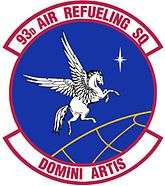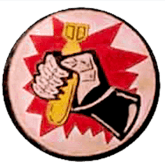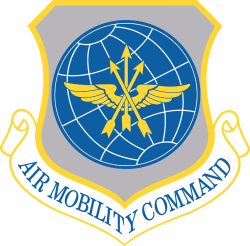93rd Air Refueling Squadron
The 93d Air Refueling Squadron is an active United States Air Force unit, stationed at Fairchild Air Force Base, Washington, where it is assigned to the 92d Operations Group and operates the Boeing KC-135 Stratotanker aircraft conducting air refueling missions.
| 93d Air Refueling Squadron | |
|---|---|
| Active | 1942-1946; 1949 – present |
| Country | |
| Branch | |
| Role | Air refueling |
| Part of | Air Mobility Command Eighteenth Air Force 92d Air Refueling Wing 92d Operations Group |
| Garrison/HQ | Fairchild Air Force Base |
| Nickname(s) | Vanguards (World War II) |
| Motto(s) | Domini Artis Latin Masters of the Art |
| Engagements | China-Burma-India Theater |
| Decorations | Distinguished Unit Citation Air Force Outstanding Unit Award with Combat V Device Air Force Outstanding Unit Award |
| Insignia | |
| 93d Air Refueling Squadron emblem(Approved 9 December 1994)[1] |  |
| 93d Air Refueling Squadron emblem (Approved 22 June 1955)[2] |  |
| 493d Bombardment Squadron emblem[3] |  |
| Aircraft flown | |
| Tanker | KC-135 Stratotanker |
History
World War II
The squadron was first activated as the 493d Bombardment Squadron in nonoperational status at Karachi, India,[note 1] and assigned to the 7th Bombardment Group on 25 Oct 1942. The squadron remained unmanned while the older squadrons of the 7th Group were converting to the Consolidated B-24 Liberator.[4] When the group and squadron moved to Pandaveswar Airfield in early January 1943 it became operational with Liberators.[1] It commenced combat operations on 26 Jan 1943.
The squadron engaged in strategic bombardment operations, attacking communications targets (roads, railroads, etc.)[1] in central and southern Burma, all without fighter escort due to the long distances involved. Primary targets were oil refineries, docks, depots, enemy airfields, marshalling yards, bridges, locomotive repair sheds, naval vessels, and troop concentrations. The 493d moved to Tezgaon Airfield, India, on 17 Jun 1944, and assumed a new mission: transporting high-octane gasoline over the Hump to bases in China. This mission lasted until 5 October, at which time the squadron moved back to Pandaveswar to resume bombing missions. A detachment of the 493d Squadron operated from Luliang Airfield, China from 17 December 1944 until 26 January 1945,[1] hauling gasoline to Suichwan Airfield, China.
The squadron proper began practice with Azon ("Azimuth only") manual command to line of sight bombs. Apparently the squadron was the only USAAF unit to use this weapon outside of the European Theater of World War II. The Azon bombs were radio controlled and could be steered left or right, although their trajectory could not be changed to shorten or lengthen their flight to target. The Azon trained crews and their B-24s were initially assigned to the 9th Bombardment Squadron. However, in December 1944, the crews and planes were reassigned to the 493d and Azon missions began to be flown. Azon proved effective in attacks against bridges and rail lines.[1][5] In early 1945 the squadron concentrated on attacks against the Burma-Thailand railroad, the most important line left to the enemy in Burma. On 19 March, the 493d earned a Distinguished Unit Citation for attacks against rail lines and bridges in Thailand.[4] The squadron also dropped propaganda leaflets in Thailand from June through September 1945 for the Office of War Information.[6]
After fighting ended in Burma the 493d Bomb Squadron was ordered to practice Azon bombing in China, but soon "alerted" for inactivation. With its parent (7th Bomb Group) the 493d staged through Dudhkundi, Kanchrapara, and Camp Angus (near Calcutta), departing Calcutta aboard the USS General W. M. Black on 7 December 1945. The vessel reached the U.S. on 5 January 1946 and the squadron inactivated at Camp Kilmer, New Jersey, the following day[1]
Strategic Air Command
Activated on 1 Mar 1949 as the 93d Air Refueling Squadron, Medium, but was not manned until September 1950. Received KB-29P Superfortress tankers, October 1950-Jun 1951. Became combat ready in October 1951. The 93d ARS deployed to RAF Upper Heyford, England, 6 Dec 1951 – 6 Mar 1952, while the parent wing was at nearby RAF Mildenhall. The squadron supported Operation FOX PETER II, the movement of the 31st Fighter-Escort Wing from the U.S. to Japan, in July 1952 using 11 KB-20Ps at Guam and Kwajalein to refuel some 58 F-84G fighters on their way to the Korean War. The squadron converted from KB-29s to KC-97G Stratotankers in November and December 1953. It undertook several oversea deployments, to Newfoundland, Greenland, French Morocco, and Alaska, in 1954-1956.
The 93d ARS began training its aircrews to operate Boeing KC-135 Stratotankers in May 1957. The squadron was the first Stratotanker squadron in the Air Force.[7] It Began receiving KC-135s on 28 Jun 1957, three days after converting to KC-135 aircrew training as primary mission. Possessed 19 tankers in December 1957 and 39 by May 1958.
Effective 1 Jul 1959, the resources of the 93d ARS were divided with the 924th ARS, which unit assumed the SAC KC-135 aircrew training mission with 15 aircraft. The 93d ARS, at the same time, resumed full-time air refueling with 20 KC-135s. This status lasted until 21 Aug 1963, when the 93d ARS ceased standing alert and prepared to resume full-time KC-135 aircrew training. On 26 August the 93d once again began KC-135 aircrew training as its primary mission. It retained Emergency War Order (EWO) commitments along with its training mission, but did not stand alert.
Modern era
The squadron's mission remained basically the same until 31 Mar 1995. Thousands of Strategic Air Command and some Air Mobility Command KC-135 aircrews received flight training from the 93 ARS. Each crew (pilot, copilot, navigator, and boom operator), after academic training with the 4017th Training Squadron at Castle AFB, received 45 days of flight training from the 93d ARS. The squadron also provided specialized training of shorter duration to senior officers (such as wing commanders). For a period the 93d ARS also sent instructor teams to locations where Air Force Reserve and Air National Guard units were converting to KC-135 tanker operations to help in-house training programs. On rare occasions the 93d had deployed some of its aircraft and crews to meet its own EWO commitments or to meet needs exceeding the capability of the 924th ARS. A few such deployments occurred in 1980. With the BRAC-directed closure of Castle AFB, On 31 Mar 1995, the 93 ARS relocated to Fairchild AFB, Washington, and became a deployable air refueling squadron under the 92d Air Refueling Wing (92 ARW).
Lineage
- 493d Bombardment Squadron
- Constituted as the 493d Bombardment Squadron (Heavy) on 19 September 1942
- Activated on 25 October 1942
- Redesignated 493d Bombardment Squadron, Heavy on 6 March 1944
- Inactivated on 6 January 1946
- Consolidated with the 93d Air Refueling Squadron as the 93d Air Refueling Squadron on 19 September 1985[1]
- 93d Air Refueling Squadron
- Constituted as the 93d Air Refueling Squadron, Medium on 2 February 1949
- Activated on 1 March 1949
- Redesignated 93d Air Refueling Squadron, Heavy on 1 February 1955
- Redesignated 93d Air Refueling Squadron on 1 September 1991
- Inactivated on 31 March 1995
- Consolidated with the 493d Bombardment Squadron on 19 September 1985
- Activated on 31 March 1995[1]
Assignments
- 7th Bombardment Group, 25 October 1942 – 6 January 1946
- 93d Bombardment Group, 1 March 1949 (attached to 93d Bombardment Wing, 15 July 1950 - 30 January 1951 and after 10 February 1951
- 93d Bombardment Wing, 16 June 1952
- 93d Operations Group, 1 September 1991
- 398th Operations Group, 1 June 1992 – 31 March 1995
- 92d Operations Group, 31 March 1995 – Present[1]
Stations
|
|
Aircraft
- Consolidated B-24 Liberator (1943–1945)
- Boeing KB-29 Superfortress (1950–1953)
- Boeing KC-97 Stratotanker (1953–1957)
- Boeing KC-135 Stratotanker (1957–1995, 1995 – present)[1]
Operations
- World War II
- Operation Desert Storm
See also
References
Notes
- Some sources give the activation location as New Delhi. However, its parent organization, the 7th Bombardment Group, was located at Karachi Airport on the day of the squadron's activation. Maurer, Combat Units, pp. 43-45.
Citations
- Kane, Robert B. (18 April 2012). "Factsheet 93 Air Refueling Squadron (AMC)". Air Force Historical Research Agency. Retrieved 27 August 2017.
- Endicott, p. 687
- Unofficial. See Maurer Combat Squadrons, p. 594 (no official emblem)
- Maurer, Combat Units, pp. 43-45
- Marion. "Old China Hands, Tales & Stories - The Azon Bomb". oldchinahands. Archived from the original on 6 March 2012. Retrieved 20 March 2012.
- Maurer Combat Squadrons, p. 594
- Shelton, A1C Taylor (31 August 2016). "Air Force celebrates 60 years of the KC-135". 92d Air Refueling Wing Public Affairs. Retrieved 23 April 2017.
Bibliography
![]()
- Endicott, Judy G. (1998). Active Air Force Wings as of 1 October 1995 and USAF Active Flying, Space, and Missile Squadrons as of 1 October 1995 (PDF). Air Force History and Museums Program. Washington, DC: Office of Air Force History. ASIN B000113MB2. Retrieved 2 July 2014.
- Maurer, Maurer, ed. (1983) [1961]. Air Force Combat Units of World War II (PDF) (reprint ed.). Washington, DC: Office of Air Force History. ISBN 0-912799-02-1. LCCN 61060979.
- Maurer, Maurer, ed. (1982) [1969]. Combat Squadrons of the Air Force, World War II (PDF) (reprint ed.). Washington, DC: Office of Air Force History. ISBN 0-405-12194-6. LCCN 70605402. OCLC 72556.
- Further reading
- Carter, Kit C.; Mueller, Robert (1972). Combat Chronology, 1941-1945 (PDF). U.S. Army Air Forces in World War II. Washington DC: Center for Air Force History. ISBN 978-0405121517. LCCN 92115046. Archived from the original (PDF) on 21 January 2015. Retrieved 6 April 2015.
External links
- "Personnel of the 493rd Bombardment Squadron". Retrieved 6 April 2015.

